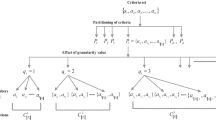Abstract
Group decision-making (GDM) requires consensus building, because an outcome from a consensual decision is indispensable to implement a highly acceptable solution. This paper proposes a novel consensus reaching method for GDM with Probabilistic Linguistic Term Set (PLTS) under a social network environment. First, the preferences and trust evaluations of decision-makers (DMs) are collected using PLTS. Then, two types of centralities are utilized to obtain the significance of DMs, and these centralities are used to derive the group evaluation. Then, a consensus measure is employed to quantify the degree of agreement within the group. To promote further consensus, a novel feedback mechanism that combines the Identification and Direction Rule-based method with an optimization-based approach is developed to achieve maximum consensus improvement in each round of modification. Moreover, DM’s bounded rationality is factored into the GDM process for a more reliable result. Finally, illustrative examples and comparison analyses are conducted to demonstrate the effectiveness of the proposed method.









Similar content being viewed by others
References
Cao M, Wu J, Chiclana F, Ureña R, Herrera-Viedma E (2020) A personalized feedback mechanism based on maximum harmony degree for consensus in group decision making. IEEE Trans Syst Man Cybern Syst 51(10):1–13
Morente-Molinera JA, Kou G, Samuylov K, Cabrerizo FJ, Herrera-Viedma E (2021) Using argumentation in expert’s debate to analyze multi-criteria group decision making method results. Inf Sci 573:433–452
Xie W, Ren Z, Xu Z, Wang H (2018) The consensus of probabilistic uncertain linguistic preference relations and the application on the virtual reality industry. Knowl Based Syst 162:14–28
Liao HC, Kuang LS, Liu YX, Tang M (2021) Non-cooperative behavior management in group decision making by a conflict resolution process and its implementation for pharmaceutical supplier selection. Inf Sci 567:131–145
Liang Q, Liao X, Liu J (2017) A social ties-based approach for group decision-making problems with incomplete additive preference relations. Knowl Based Syst 119:68–86
Tan X, Zhu J, Zhang Y (2020) A consensus reaching process with quantum subjective adjustment in linguistic group decision making. Inf Sci 533:150–168
Tang M, Liao HC, Mi XM, Lev B, Pedrycz W (2021) A hierarchical consensus reaching process for group decision making with noncooperative behaviors. Eur J Oper Res 293(2):632–642
Wang H, Yu DJ, Xu ZS (2021) A novel process to determine consensus thresholds and its application in probabilistic linguistic group decision-making. Expert Syst Appl 168:114315
Zhang Z, Li ZL, Gao Y (2021) Consensus reaching for group decision making with multi-granular unbalanced linguistic information: a bounded confidence and minimum adjustment-based approach. Inf Fus 74:96–110
Wu Q, Liu XW, Qin JD, Zhou LG (2021) Multi-criteria group decision-making for portfolio allocation with consensus reaching process under interval type-2 fuzzy environment. Inf Sci 570:668–688
Rodríguez RM, Labella Á, Dutta B, Martínez L (2021) Comprehensive minimum cost models for large scale group decision making with consistent fuzzy preference relations. Knowl Based Syst 215:106780
Zhang H, Dong Y, Chiclana F, Yu S (2019) Consensus efficiency in group decision making: a comprehensive comparative study and its optimal design. Eur J Oper Res 275:580–598
Jin FF, Cao M, Liu JP, Martínez L, Chen HY (2021) Consistency and trust relationship-driven social network group decision-making method with probabilistic linguistic information. Appl Soft Comput 103:107170
Li YH, Kou G, Li GX, Wang HM (2021) Multi-attribute group decision making with opinion dynamics based on social trust network. Inf Fus 75:102–115
Gai TT, Cao MS, Cao QW, Wu J, Yu GF, Zhou M (2020) A joint feedback strategy for consensus in large-scale group decision making under social network. Comput Ind Eng 147:106626
Wu NN, Xu YJ, Liu X, Wang HM, Herrera-Viedma E (2020) Water–Energy–Food nexus evaluation with a social network group decision making approach based on hesitant fuzzy preference relations. Appl Soft Comput 93:106363
Tian ZP, Nie RX, Wang JQ (2019) Social network analysis-based consensus-supporting framework for large-scale group decision-making with incomplete interval type-2 fuzzy information. Inf Sci 502:446–471
Rodríguez RM, Martínez L, Herrera F (2012) Hesitant fuzzy linguistic terms sets for decision making. IEEE Trans Fuzzy Syst 20:109–119
Pang Q, Wang H, Xu Z (2016) Probabilistic linguistic term sets in multi-attribute group decision making. Inf Sci 369:128–143
Wu X, Liao HC (2018) An approach to quality function deployment based on probabilistic linguistic term sets and ORESTE method for multi-expert multi-criteria decision making. Inf Fus 43:13–26
Kahneman D, Tversky A (1979) Prospect theory: an analysis of decision under risk. Econometrica 47(2):263–291
Freeman LC (1977) A set of measures of centrality based on betweenness. Sociometry 40:35–41
Freeman LC, Borgatti SP, White DR (1991) Centrality in valued graphs: a measure of betweenness based on network flow. Soc Netw 13(2):141–154
Wu Z, Xu J (2018) A consensus model for large-scale group decision making with hesitant fuzzy information and changeable clusters. Inf Fus 41:217–231
Zhang Z, Gao Y, Li ZL (2020) Consensus reaching for social network group decision making by considering leadership and bounded confidence. Knowl Based Syst 204:106240
Liu Y, Liang C, Chiclana F, Wu J (2017) A trust induced recommendation mechanism for reaching consensus in group decision making. Knowl Based Syst 119:221–231
Cheng SM, Cheng SH, Lin TE (2015) Group decision making systems using group recommendations based on interval fuzzy preference relations and consistency matrices. Inf Sci 298:555–567
Zhang H, Palomares I, Dong Y, Wang W (2018) Managing non-cooperative behaviors in consensus-based multiple attribute group decision making: an approach based on social network analysis. Knowl Based Syst 162:29–45
Author information
Authors and Affiliations
Corresponding author
Additional information
Publisher's Note
Springer Nature remains neutral with regard to jurisdictional claims in published maps and institutional affiliations.
Rights and permissions
About this article
Cite this article
Hua, Z., Xue, H. A Maximum Consensus Improvement Method for Group Decision Making Under Social Network with Probabilistic Linguistic Information. Neural Process Lett 54, 437–465 (2022). https://doi.org/10.1007/s11063-021-10639-y
Accepted:
Published:
Issue Date:
DOI: https://doi.org/10.1007/s11063-021-10639-y




